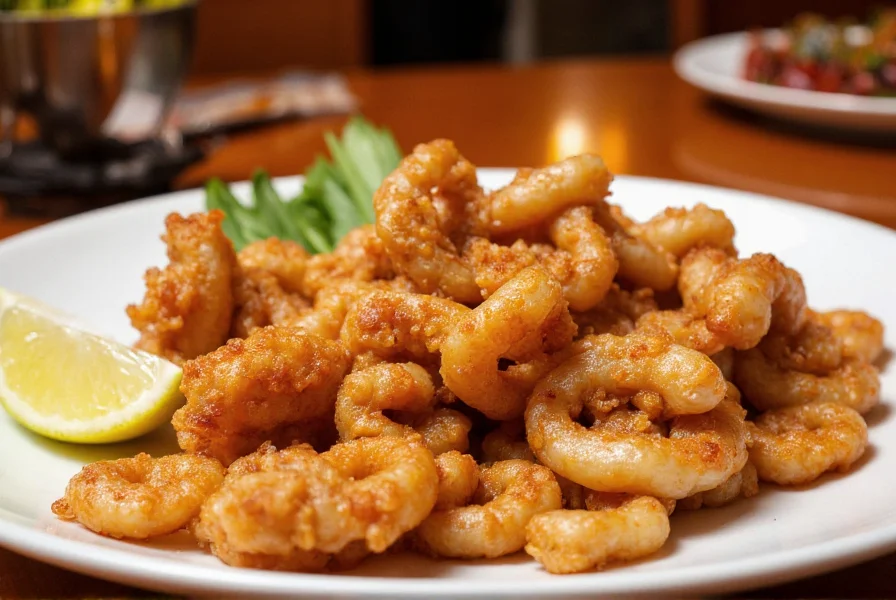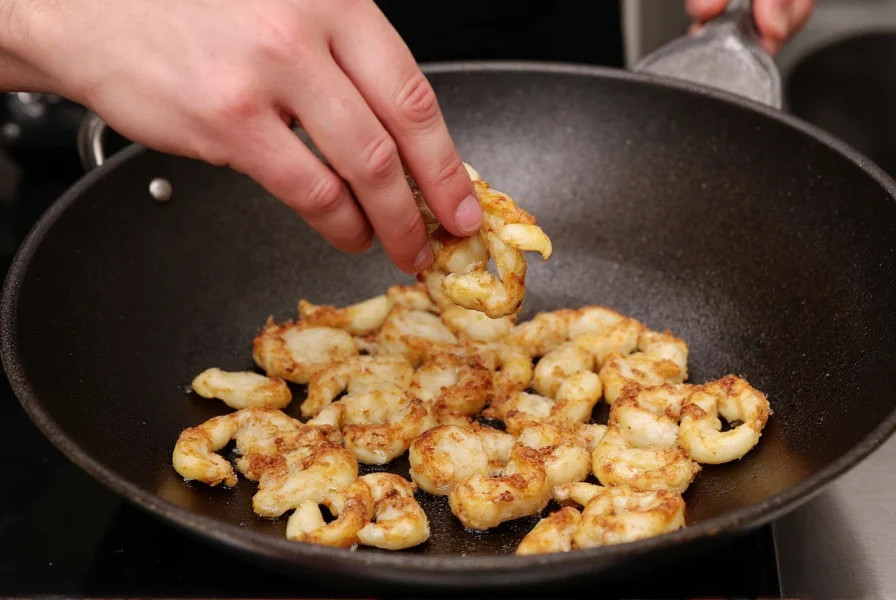The Culinary Journey of Salt Pepper Squid
Salt pepper squid has evolved from humble Chinese street food to a global menu staple. While its exact origins remain debated among culinary historians, most agree it emerged from coastal Chinese communities where fresh squid was abundant. The dish gained international popularity through Cantonese restaurants and later became particularly beloved in Australia during the 1980s pub food revolution. Today, variations of salt pepper squid appear on menus from London to Los Angeles, each region adding subtle twists while maintaining the essential flavor profile that makes this dish so universally appealing.

Essential Components for Authentic Salt Pepper Squid
The magic of exceptional salt pepper squid happens through careful ingredient selection and preparation. Unlike many fried seafood dishes, this recipe relies on minimal ingredients to showcase the squid's natural flavor.
Squid Selection and Preparation
Choosing the right squid makes or breaks your dish. Fresh squid should have a clean ocean scent and firm, slightly translucent flesh. Avoid specimens with yellowing or strong fishy odors. When preparing squid for salt pepper squid:
- Remove the quill (internal backbone) completely
- Peel off the thin outer membrane for optimal texture
- Cut tubes into 1.5-inch rings, maintaining uniform thickness
- Pat pieces thoroughly dry before coating
The Perfect Seasoning Blend
The "salt and pepper" in salt pepper squid isn't as simple as it sounds. Traditional recipes use:
| Ingredient | Proportion | Special Preparation |
|---|---|---|
| Freshly ground black pepper | 2 parts | Coarsely ground for texture and aroma release |
| Sea salt | 1 part | Mixed with 10% five-spice powder for complexity |
| Garlic | 3-4 cloves per pound of squid | Thinly sliced for crisp texture |
| Chili | Optional | 1-2 dried red chilies for subtle heat |
Mastery of Cooking Technique
Even with perfect ingredients, improper technique can ruin salt pepper squid. The critical factors separate good from exceptional versions of this classic dish.
Frying Temperature Control
Oil temperature represents the single most crucial factor in achieving perfect salt pepper squid. Professional chefs maintain these temperature guidelines:
- First fry: 325°F (163°C) for 45-60 seconds to set the coating
- Rest period: 2 minutes at room temperature
- Second fry: 375°F (190°C) for 20-30 seconds for ultimate crispness
Skipping the double-fry technique often results in greasy, unevenly cooked squid. The initial lower temperature sets the batter without burning, while the higher second temperature creates the signature crisp exterior.
Seasoning Application Timing
Many home cooks make the critical error of seasoning squid before frying. For authentic salt pepper squid:
- Fry squid until golden and crisp
- Drain excess oil thoroughly
- Return to wok over high heat with minimal oil
- Add seasoning blend and aromatics
- Toss vigorously for 30-45 seconds until evenly coated
This technique ensures the seasoning adheres properly without becoming soggy or burning during the frying process.

Regional Variations Worth Exploring
While the core concept remains consistent, regional interpretations of salt pepper squid offer fascinating culinary insights:
Chinese Traditional Preparation
The original version features minimal seasoning beyond salt, pepper, and garlic, often served with a side of chili vinegar for dipping. The squid remains the undisputed star, with seasoning playing a supporting role.
Australian Pub Style
Australian adaptations typically feature a thicker batter coating and more aggressive seasoning. Many Australian restaurants add a splash of rice wine during the final toss and serve with lemon wedges rather than vinegar.
Southeast Asian Twists
In Thailand and Vietnam, chefs often incorporate lemongrass and kaffir lime leaves into the seasoning blend, creating a more aromatic profile that complements the salt and pepper foundation.
Perfect Pairings for Salt Pepper Squid
The right accompaniments elevate salt pepper squid from a simple appetizer to a complete culinary experience:
- Beer pairing: Crisp lagers or pilsners cut through the richness
- Wine pairing: Dry Riesling or unoaked Chardonnay
- Dipping sauces: Chili vinegar, sweet chili sauce, or simple lemon wedges
- Side dishes: Steamed jasmine rice or simple green salad
Troubleshooting Common Salt Pepper Squid Problems
Even experienced cooks encounter challenges with this deceptively simple dish. Here's how to solve frequent issues:
Rubbery Squid Texture
Cause: Overcooking or improper squid preparation
Solution: Ensure squid is completely dry before frying, maintain precise oil temperature, and limit total frying time to 90 seconds maximum.
Excessive Oil Absorption
Cause: Incorrect oil temperature or overcrowding the fryer
Solution: Use a thermometer to verify temperature, fry in small batches, and implement the double-fry technique described earlier.
Uneven Seasoning Distribution
Cause: Adding seasoning during frying or improper tossing technique
Solution: Season after frying using high heat and vigorous tossing in a preheated wok for 30-45 seconds only.
Conclusion: Mastering the Art of Salt Pepper Squid
Salt pepper squid represents culinary perfection through simplicity. By understanding the essential techniques for squid preparation, precise temperature control, and proper seasoning application, home cooks can recreate this beloved dish with restaurant-quality results. The most successful preparations honor the delicate balance between the squid's natural sweetness and the aromatic punch of the signature seasoning blend. Whether enjoying it at your favorite Asian restaurant or preparing it at home, authentic salt pepper squid continues to delight seafood enthusiasts worldwide with its irresistible combination of crisp texture and savory flavor.
Frequently Asked Questions
What's the best type of squid for salt pepper squid?
The best squid for salt pepper squid comes from smaller varieties like calamari or baby squid, which have naturally tender texture. Look for fresh, firm squid with a clean ocean scent. Avoid larger squid varieties which tend to be tougher and require more careful preparation to prevent rubberiness.
Can I make salt pepper squid without deep frying?
While traditional salt pepper squid requires deep frying for optimal texture, you can achieve reasonable results using an air fryer. Pat squid extremely dry, coat lightly with cornstarch, and cook at 400°F (200°C) for 8-10 minutes, flipping halfway. The texture won't be identical to deep-fried versions, but it will maintain the essential salt pepper flavor profile with less oil absorption.
How do I prevent salt pepper squid from becoming rubbery?
To prevent rubbery salt pepper squid: 1) Ensure squid is completely dry before coating, 2) Maintain precise oil temperature (325°F then 375°F), 3) Limit total cooking time to 90 seconds maximum, 4) Never overcrowd the fryer, and 5) Use fresh, high-quality squid. Properly prepared squid should have a tender yet slightly chewy texture, never tough or rubbery.
What's the difference between salt pepper squid and calamari?
While both dishes feature fried squid, salt pepper squid specifically refers to the Chinese preparation with a distinctive salt and pepper seasoning blend applied after frying. Calamari typically uses a simpler batter and is often served with marinara sauce. Salt pepper squid emphasizes the aromatic pepper flavor, while traditional calamari focuses more on the squid's natural taste with minimal seasoning.
Can I prepare salt pepper squid ahead of time?
Salt pepper squid is best enjoyed immediately after preparation, as the crisp texture deteriorates quickly. If you must prepare ahead, cook the squid through the first fry, then complete the second fry and seasoning just before serving. Never fully prepare and store salt pepper squid, as it will become soggy and lose its signature crispness. For optimal results, serve within 5-10 minutes of final preparation.











 浙公网安备
33010002000092号
浙公网安备
33010002000092号 浙B2-20120091-4
浙B2-20120091-4